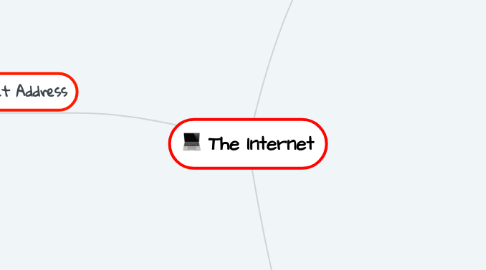
1. Internet Address
1.1. A number that uniquely identifies each computer or device connected to the internet
1.2. IP Address
1.2.1. IP (Internet Protocol) - The protocol that provides for addressing and routing Internet packets from one computer to another
1.2.2. Definition
1.2.2.1. A number that uniquely identifies each computer or device connected to the internet
1.2.2.2. A unique 32-bit number assigned to network devices that use Internet Protocol
1.3. Types
1.3.1. IPv4
1.3.1.1. Version 4 of Internet Protocol,the most widely used version of IP
1.3.2. IPv6
1.3.2.1. Version of Internet Protocol,has more capabilities than IPv4,including providing for far more IP address
1.4. Domain Name
1.4.1. The text version of an IP address
1.4.2. Top-level domain (TLD)
1.4.2.1. The last section of the domain name
1.4.2.1.1. E.g: TLD :aero-aviation community members
1.4.2.2. For music and online broadcasting
1.4.2.2.1. .fm , .ikim, .astro
1.4.3. Purpose of Top- Level domain (TLD)
1.4.3.1. Identifies the type of organization associated with the domain
1.4.4. Country Code Top-Level domain
1.4.4.1. E.g : my- Malaysia
2. Types of Internet Connection
2.1. DIal-up Connection
2.1.1. PC has to dial via a phone line to connect
2.1.2. Conventional dial-up
2.1.2.1. Slower but cheaper
2.1.2.2. Ties up phones lines
2.1.2.3. Relatively secure from hackers
2.1.2.4. Advantages
2.1.2.4.1. Security
2.1.2.4.2. Include inexpensive hardware
2.1.2.4.3. Ease to setup and use
2.1.2.4.4. Widespread availability
2.1.2.5. Disadvantages
2.1.2.5.1. Slow connection speed
2.1.2.5.2. Inconvenience
2.1.2.5.3. Telephone line will be tied up while accessing the Internet
2.2. Used in home and office
2.3. Broadband Internet Connection
2.3.1. Director Connection/always on-connections
2.3.2. Continually connected to the internet
2.3.3. Types of broadband connection
2.3.3.1. DSL
2.3.3.2. Fiber to the Premises(FTTP)
2.3.3.3. Fixed wireless
2.3.3.4. Cellular Radio Network
2.3.3.5. Cable Internet service
2.3.3.6. Wi-Fi
2.3.3.7. Satelite Internet Service
3. ISP (Internet service provider)
3.1. Access Providers - Business that provides individuals and organizations access to the Internet for free or for a fee
3.1.1. Regional ISPs
3.1.1.1. Provide Internet acces tou a specific geographical area
3.1.2. National ISPs
3.1.2.1. Provide Internet access in cities and towns nationwide
3.2. Responsibilities
3.2.1. Providing and maintaining a connection
3.2.2. Support hardware and software needed to service that connection
3.2.3. Protect their sites froum external threats, e.g: Viruses,hackers
3.2.4. Provides 24 hours customer service and technical support
3.3. Examples of ISP
3.3.1. TMNet
3.3.2. Maxis
3.3.3. Celcom
3.3.4. Packet One Network
3.3.5. Umobile

